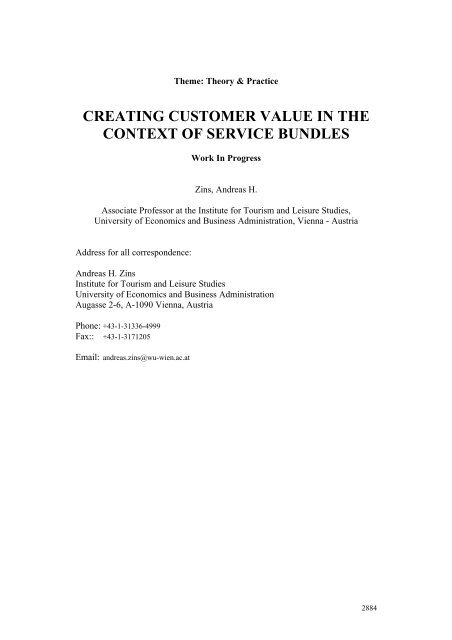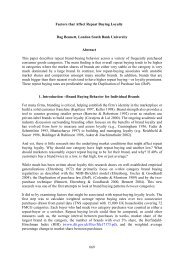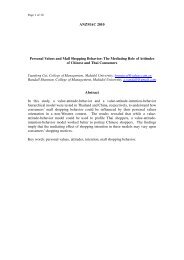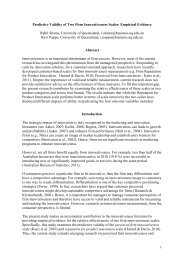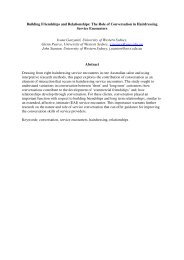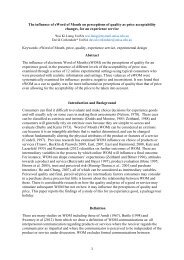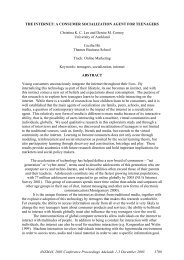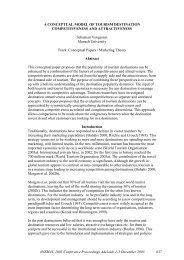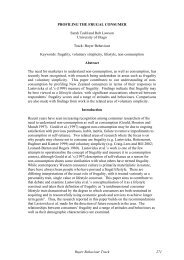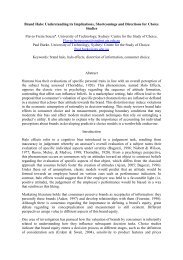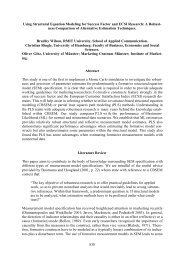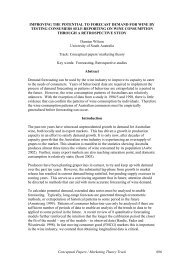Full Paper - ANZMAC
Full Paper - ANZMAC
Full Paper - ANZMAC
Create successful ePaper yourself
Turn your PDF publications into a flip-book with our unique Google optimized e-Paper software.
Theme: Theory & Practice<br />
CREATING CUSTOMER VALUE IN THE<br />
CONTEXT OF SERVICE BUNDLES<br />
Work In Progress<br />
Zins, Andreas H.<br />
Associate Professor at the Institute for Tourism and Leisure Studies,<br />
University of Economics and Business Administration, Vienna - Austria<br />
Address for all correspondence:<br />
Andreas H. Zins<br />
Institute for Tourism and Leisure Studies<br />
University of Economics and Business Administration<br />
Augasse 2-6, A-1090 Vienna, Austria<br />
Phone: +43-1-31336-4999<br />
Fax:: +43-1-3171205<br />
Email: andreas.zins@wu-wien.ac.at<br />
2884
CREATING CUSTOMER VALUE IN THE<br />
CONTEXT OF SERVICE BUNDLES<br />
ABSTRACT<br />
Work In Progress<br />
Following Holbrook’s axiological typology of customer value service quality is<br />
supposed to contribute to the formation of customer value. Yet, to better<br />
understand the antecedents of customer satisfaction and customer loyalty it is<br />
claimed to make major refinements of traditional and classical consumer<br />
behaviour models. A revised preference model for complex services is proposed<br />
and illustrated by the example of a holiday trip. Revisions and adaptations are<br />
suggested in order to integrate already known but so far disconnected issues. The<br />
marketing and research perspective has to turn its focus from attribute or benefit<br />
bundles to the consumption experience. This issue emphasises the means-end<br />
relationship inherent in any consumption activity. Buying and consumption<br />
processes are always accompanied by trade-off evaluations between benefits<br />
sought and disadvantages avoided. Neither service quality models nor perceived<br />
risk models capture this aspect adequately. Finally, it is argued that the product<br />
conceptualisation is to be extended by situational factors and the customer<br />
participation which both are constitutional elements in the process of service<br />
production/consumption.<br />
Keywords: service bundles, customer participation, service quality, customer<br />
value, tourism products.<br />
2885
INTRODUCTION<br />
Whether services are rendered in the presence or the absence of an object or<br />
subject, they offer a bundle of benefits to the customer like products do (Enis and<br />
Roering 1981; Lovelock 1981). The distinction between goods and services has<br />
been discussed for decades (Judd 1968; Blois 1974; Bateson 1977; Shostack<br />
1979), though the key criteria intangibility, inseparability, and variability (Kotler<br />
1980) have not entered the grand consumer behaviour models (e.g. Howard and<br />
Sheth 1969; Engel, Kollat and Miniard 1993) appropriately. Hence, it is claimed<br />
that consumer behaviour models focusing on the evaluation of alternatives and on<br />
post-choice evaluation have to be adapted whenever service components do not<br />
play but a negligible role. This will be illustrated by an example of the tourism<br />
industry where often bundles of tangible and intangible products are marketed and<br />
consumed simultaneously. Holiday or business trips similar to e.g. car<br />
maintenance services, financial services or dental services represent service<br />
bundles which vary in their degree of complexity. Various dimensions of product<br />
complexity can be differentiated (Güthoff 1995) and are influential in pre- and<br />
post-choice evaluation processes.<br />
The holiday preference (and satisfaction) model proposed in this paper tries to<br />
integrate three issues that have been considered separately in the literature so far.<br />
1. Products and services “potentially provide value-creating consumption<br />
experiences.” (Holbrook 1994, p. 21). Quality concepts based on expected and<br />
delivered attribute levels are only one dimension of the value realm. This<br />
perspective is supported by the means-end chain theory (Gutman 1982). 2. The<br />
buying and consumption decisions are always trade-offs between benefits and<br />
disadvantages (Gutman and Reynolds 1983, p. 40). This claim is based on the<br />
underlying exchange process between two agents who both, give up something of<br />
value for obtaining something else of value (Kotler 1991). 3. The social and<br />
physical context of this exchange process shall be incorporated in the<br />
conceptualisation of products and services (Berry 1981; Lovelock 1981; Grove<br />
and Fisk 1983). According to the experiential nature of services it is important to<br />
marketing managers how customer participation (Kellogg et al. 1997; Bitner et al.<br />
1997) and atmospherics (Kotler 1973; Bitner 1992) impact customer satisfaction.<br />
These issues will be discussed in more detail before illustrating the proposed<br />
model.<br />
COMPLEX SERVICES AND CUSTOMER ROLES<br />
Tourism products are predominantly complex product (and service) bundles.<br />
Customers are forced sometimes to choose among a limited number of entirely<br />
pre-packaged tourism products and are sometimes completely free to make<br />
individual arrangements. In some instances they will decide upon product details<br />
far in advance, in other situations they postpone the final decision making until<br />
the immediate consumption. In general, various aspects of the degree and<br />
2886
structure of complexity have been outlined (Güthoff 1995). The effects of<br />
complexity on service quality and customer satisfaction have been investigated<br />
only selectively: e.g. number of bundle elements (Danahar and Mattsson 1998)<br />
and duration of services (Czepiel et al. 1985, Danahar and Mattsson 1994, 1998;<br />
Geva und Goldman 1989) whereas criteria such as “multiple individuals<br />
involved”, “heterogeneity of bundle elements”, and “degree of individuality of the<br />
product” are still open for research.<br />
For marketing purposes it is essential to know what elements in a product and<br />
service bundle play a key role in the customer’s decision-making process.<br />
Bundling strategies in a competitive environment – first systematically outlined<br />
by Guiltinan (1987) – have their focus on product development and finding<br />
optimal prices. Similar problems in the tourism and hospitality context have been<br />
discussed by Kinberg and Sudit (1979), Green and Wind (1984), Sheldon and<br />
Mak (1987), and Bojanic and Calantone (1990). Nevertheless, their research<br />
approach is limited predominantly to the financial evaluation of quite a few<br />
product attributes and does not incorporate the instrumental role of those<br />
attributes in creating value and satisfaction to the customer.<br />
Therefore, it is essential to identify the various roles customers may play in the<br />
production process. Bitner et al. (1997) distinguish between three different roles:<br />
the customer as productive resource, the customer as contributor to quality,<br />
satisfaction and value, and the customer as competitor to the service organisation.<br />
According to these roles, different abstract levels of customer participation may<br />
occur: low level: only customer presence required (e.g. airline travel, fast-food<br />
restaurant), moderate level: customer inputs required (e.g. hair cut, advertising<br />
campaign), high level: customer co-creates service products (e.g. weightreduction<br />
programme, management seminar). Related issues have been raised<br />
addressing organisational socialisation by Bowen and Schneider (1985), Kelley et<br />
al. (1992), Lusch, Brown and Brunswick (1992) or the intrinsic attraction of selfservice<br />
by Bateson (1983, 1985) and Dabholkar (1996) or the relationship<br />
between satisfaction and failure attribution by Bitner (1990), Folkes (1988) and<br />
Hubbert (1995).<br />
If we take the experiential nature of services seriously (Lovelock 1979) we cannot<br />
separate the service’s personnel and environment from the consumer (Bateson<br />
1979). The situation in which the service consumption takes place involves<br />
several dimensions. Kotler (1973) addressed the physical setting by<br />
“atmospherics” including all perceptions of the five human senses. When Grove<br />
and Fisk (1983) discussed the dramaturgical perspective of service exchange<br />
processes both, the physical and social settings were integrated. Bagozzi (1975)<br />
emphasised the idea of symbolic exchange which is not limited to the core<br />
elements of products and services but extends to the physical environment as well<br />
as to the social interaction. Bitner (1992) proposed three dimensions of the socalled<br />
“servicescapes”: ambiente condition, spatial layout and functionality, and<br />
2887
signs and symbols which contribute to the achievement of organisational and<br />
marketing goals.<br />
The following Figure 1 shall illustrate and demonstrate that the specific situation<br />
and the consumer are constitutional elements of any service oriented industry.<br />
Figure 1: Extended product conceptualisation<br />
Supplier<br />
Retailer<br />
delivery, usage rights<br />
influence<br />
Product<br />
Service<br />
contribution - experience - evaluation<br />
Situation<br />
influence<br />
contribution - consumption<br />
experience - evaluation<br />
influence<br />
Consumer<br />
At the phase of evaluating product (travel) alternatives the potential traveller may<br />
consult previous experiences, recommendations and stories from others,<br />
catalogues, brochures, videos, media reports and other sources (Schmoll 1977,<br />
Mathieson and Wall 1982, Moutinho 1987, Goodall 1991). He/She has some –<br />
more or less- vague perceptions about the particular travel elements<br />
(transportation, accommodation, catering, guides, sporting and recreation<br />
facilities). Nevertheless, the customer, first, anticipates his/her contribution to the<br />
entire production process and the consumption situation and, later, influences the<br />
realisation. In contrast, the supplier/retailer sells implicitly not only the travel<br />
products and services but a situation as well: implicitly (e.g. climatic conditions)<br />
or explicitly (e.g. the atmosphere of a club resort). Consequently, evaluative<br />
processes – pre- or post-experience – on the part of the consumer are not restricted<br />
to the product and service attributes in a narrow sense.<br />
Adopting such an extended conceptualisation of products and services the<br />
question is raised to which degree traditional cognitivistic approaches (e.g. multiattribute<br />
attitude models) for modelling choice and post-choice evaluation seem to<br />
be appropriate and efficient. According to Güthoff (1995) the various service<br />
quality models (e.g. Grönroos 1984, Corsten 1986) proposed in the literature are<br />
2888
only apt to a limited degree to fully capture the complex service bundles.<br />
However, while these models strongly emphasise the characteristics of the<br />
services including process or interaction qualities, they neither consider explicitly<br />
the situational factors nor the customer contribution. Bitner (1992) shows in her<br />
servicescape framework theoretically that cognitive, emotional and physiological<br />
responses on the part of the customer and on the part of the employee are<br />
conceivable. These responses depend on environmental conditions (three<br />
dimensions of the servicescape) and are moderated by personal traits and<br />
situational factors. Though crowding phenomena are explicitly addressed within<br />
the spatial layout dimension, psycho-social influences deriving from foreign<br />
situations (e.g. different language, different habits and customs, multiple cultures<br />
represented by other consumers and/or employees) do not appear in her<br />
framework.<br />
QUALITY AND VALUE CONCEPTS RECONSIDERED<br />
Reviews of the abundant customer satisfaction literature (e.g. Yi 1991, Anderson<br />
and Fornell 1994) show some evidence that the central – and in numerous cases<br />
unique – source of customer satisfaction is quality. However, there is no product<br />
or service that is valuable by itself but through the value creation with a consumer<br />
(interactionist view). This valuation emerges on different dimensions<br />
(intrinsic/extrinsic, active/reactive, and self-oriented/other oriented) and was<br />
defined as an interactive relativistic preference experience (see Holbrook 1994).<br />
Quality or excellence appears in Holbrook’s value typology as an extrinsic,<br />
reactive and self-oriented value dimension. The quality concepts formulated by<br />
Zeithaml (1988) and Steenkamp (1989) fit into this terminology emphasising the<br />
instrumentality and achievement of usage goals. Yet, the operationalisation of the<br />
quality constructs has shifted either to the higher level abstraction of the service<br />
encounter (e.g. SERVQUAL) or to simple multi-attribute models on the product<br />
level. Both approaches are related but opposed to the attitude model developed by<br />
Ajzen and Fishbein (1977) or the expectancy-value model (Vroom 1964, Witt and<br />
Wright 1992) as they do not make explicit the relationships between product<br />
characteristics and more abstract consumer goals (Gutman 1982, Woodruff and<br />
Gardial 1996).<br />
According to the degree of customer participation and integration in the<br />
production process (Engelhardt et al. 1993) and the interaction with situational<br />
components the consumer perceives the utility or disutility of the entire service<br />
experience or elements thereof. Preference building, decision making as well as<br />
post-experience evaluation can always be expressed by approach and avoidance<br />
criteria. This is consistent with the trade-off perspective between benefits and<br />
disadvantages (Gutman and Reynolds 1983) and the exchange process paradigm<br />
of production and consumption activities (Kotler 1991).<br />
2889
Perceived risk models predominantly take care about the negative outcome or<br />
consequences of the buying decision or consumption process. In addition to<br />
functional and product risks other criteria such as political, weather, or crowding<br />
( situation) and physical, time, or financial risks ( person/customer) have<br />
been considered in various models (e.g. Kaplan et al. 1974; Mitchell and Boustani<br />
1994; Roehl and Fesenmaier 1992; Stone and Gronhaug 1993; Chaudhuri 1998).<br />
Addressing some of the constitutional domains of the service experience (cf.<br />
Figure 1: product, situation, consumer) the risk approach decides a priori to<br />
concentrate on the negative aspects of the exchange process. Without taking the<br />
benefit side into account different weights for the various instrumentalities of the<br />
service experience cannot be derived.<br />
Hence, two methodological differences exist between quality models of any shape<br />
and perceived risk models: 1. While the former emphasises on the positive aspects<br />
related to the consumption experience the latter focuses on the negative<br />
consequences. 2. The two approaches have different cognitive levels. While<br />
quality models operate either on the attribute level or on intermediate<br />
consumption goals (expected, perceived), risk models concentrate on the negative<br />
instrumentalities of attributes. The integration of both perspectives could give<br />
much more insight into the structure of preference building and satisfaction<br />
generation than separate approaches.<br />
This claim can be consistently embedded in the value framework outlined by<br />
Woodruff (1997, p. 142): “Customer value is a customer's perceived preference<br />
for and evaluation of those product attributes, attribute performances, and<br />
consequences arising from use that facilitate (or block) achieving the customer's<br />
goals and purposes in use situations. …it links together products with use<br />
situations and related consequences experienced by goal-oriented customers. This<br />
definition is anchored in a conceptual framework provided by a means-end type of<br />
model.”<br />
This value framework follows a hierarchical value concept (Rokeach 1973; Kahle<br />
1984; Grunert 1990; Patterson and Spreng 1997) and puts “give” and “get”<br />
components together. “Give” components are – in this extended product<br />
conceptualisation – not limited to the customer’s financial contributions but<br />
include any sacrifice (physical, psychological, time) necessary to achieve the<br />
intended consumption experience.<br />
SYNTHESIS AND IMPLICATIONS<br />
A re-designed framework for measuring and creating customer value for complex<br />
tourism bundles is outlined in Figure 2. It is labelled holiday preference model<br />
though it is not limited to this kind of product classes and could be generalised to<br />
a service preference model. It is based on the following principles discussed in the<br />
previous sections:<br />
2890
1. Extended product conceptualisation: the “delivered” products (and services),<br />
the consumption situation and the consumer, altogether, give gestalt to the<br />
travel experience.<br />
2. Consumers may express their desired level of the attributes or characteristics<br />
of all three domains associated with the relevant alternatives (Spreng,<br />
MacKenzie and Olshavsky 1996). The product domains may have positive or<br />
negative instrumentalities: benefits sought or inconveniences avoided.<br />
3. These evaluative criteria (benefits, disadvantages) are applicable to a<br />
particular product class (e.g. holiday trips) within which product alternatives<br />
can be evaluated.<br />
4. These criteria are dependent from more abstract cognitive levels such as<br />
personal values, motives and the static-dynamic orientation (Wicklund 1986;<br />
Gnoth et al. 1998).<br />
5. Give and get components, both, contribute to a perceived overall value that<br />
differentiates according to the source of contribution (product, situation,<br />
customer) and the product alternative (Woodruff 1997).<br />
6. Combined together, these three value components yield a preference for a<br />
particular alternative. In general, the product with the highest preference<br />
ranking will be chosen. Of course, unforeseen obstacles, personal (time<br />
restrictions, sickness) or supply side factors (unavailability) may bias the link<br />
between preference order and buying act.<br />
Figure 1: Holiday Preference Model<br />
Values<br />
Motives<br />
Static/<br />
dynamic<br />
orientation<br />
Inconveniences<br />
avoided<br />
Benefits<br />
sought<br />
Instrumentality<br />
Product<br />
attributes<br />
Situation<br />
attributes<br />
Consumer<br />
attributes<br />
strength of belief<br />
expectations<br />
Product<br />
value<br />
Situation<br />
value<br />
Consumer<br />
value<br />
Preferences<br />
2891
Several steps of the elaboration of this preference model are not yet finished:<br />
• The conditions of its applicability have to be discussed in detail. It is set out to<br />
be useful in tourism and applicable in other complex service contexts as well.<br />
• The operationalisation of the core evaluative elements (beliefs about<br />
attributes, links to benefits and inconveniences) is still under construction. A<br />
means-end approach (laddering technique) seems to be appropriate.<br />
• The empirical test and application shall deliver the practical evidence for the<br />
superiority of the model.<br />
Despite these present limitations the following advantages should be mentioned:<br />
• The model envisages high unifying power with integrating numerous existing<br />
theories and concepts.<br />
• The framework can be applied for a preference model in the pre-choice<br />
situation as well as for a satisfaction model in the post-choice situation<br />
without changing the basic concepts and conceptual links.<br />
REFERENCES<br />
Ajzen, I. and Fishbein, M. (1977), Attitude-behavior relations: a theoretical<br />
analysis and review of empirical research. Psychological Bulletin, 84,888-918.<br />
Anderson, E.W. and Fornell, C. (1994), A customer satisfaction research<br />
prospectus, in Rust, R.T. and Oliver, R.L. (eds.), Service quality. New Directions<br />
in Theory and Practice, Thousand Oaks, CA, Sage Publications, 241-268.<br />
Bagozzi, R.P. (1975), Marketing as exchange. Journal of Marketing, 30(October),<br />
32-39.<br />
Bateson, J.E.G. (1977), Do we need service marketing. Marketing Consumer<br />
Services: New Insights, Report 77-115, Boston, Marketing Science Insitute.<br />
Bateson, J.E.G. (1979), Why we need services marketing, in Ferrell, O.C., Brown,<br />
S.W. and Lamb, C.W. (eds.), Conceptual and theoretical development in<br />
marketing, Chicago, American Marketing Association, 131-146.<br />
Bateson, J.E.G. (1983), The self-service customer – empirical findings, in Berry,<br />
L.L., Shostack, B.L. and Upah, G.D. (eds.), Emerging perspectives on services<br />
marketing, Chicago, IL, American Marketing Association, 50-53.<br />
Bateson, J.E.G. (1985), The self-service customer: an exploratory study. Journal<br />
of Retailing, 61(3), 49-76.<br />
2892
Berry, L.L. (1981), Perspectives on the retailing of services, in Stampfl, R.W. and<br />
Hirschman, E.C. (eds.), Theory in retailing: traditional and nontraditional sources,<br />
Chicago, American Marketing Association, 9-20.<br />
Bitner, M.J. (1990), Evaluating service encounters: the effects of physical<br />
surroundings and employee responses. Journal of Marketing, 58, 95-106.<br />
Bitner, M.J. (1992), Servicescapes: The Impact of Physical Surroundings on<br />
Customers and Employees. Journal of Marketing, 56, 57-71.<br />
Bitner, M.J., Faranda, W.T., Hubbert, A.R. and Zeithaml, V.A. (1997), Customer<br />
contributions and roles in service delivery. International Journal of Service<br />
Industry Management, 8(3), 193-205.<br />
Blois, K.J. (1974), The marketing of services: an approach. Journal of Marketing,<br />
8, 137-149.<br />
Bojanic, D.C. and Calantone, R.J. (1990), A contribution approach to price<br />
bundling in tourism. Annals of Tourism Research, 17, 528-540.<br />
Bowen, D.E. and Schneider, B. (1985), Boundary-spanning-role employees and<br />
the service encounter: some guidelines for management and research, in Czepiel,<br />
J.A., Solomon, M.R. and Surprenant, C.F. (eds.), The service encounter,<br />
Lexington, MA, Lexington Books, 127-148.<br />
Chaudhuri, A. (1998), Product class effects on perceived risk: The role of<br />
emotion. International Journal of Research in Marketing, 15, 157-168<br />
Corsten, H. (1986), Zur Diskussion der Dienstleistungsbesonderheiten und ihre<br />
ökonomischen Auswirkungen. Jahrbuch der Absatz- und Verbrauchsforschung,<br />
32(1), 16-41.<br />
Czepiel, J.A., Solomon, M.R., Surprenant, C.F. and Gutman, E. (1985), Service<br />
encounters: an overview, in the service encounter. , Czepiel, J.A., Solomon, M.R.<br />
(eds.), Managing Employee/Customer Interaction in Service Businesses,<br />
Lexington, MA, Lexington Books.<br />
Dabholkar, P.A. (1996), Consumer evaluations of new technology-based selfservice<br />
options: an investigation of alternative models of service quality.<br />
International Journal of Research in Marketing, 13(1), 29-51.<br />
Danahar, P.J. and Mattsson, J. (1994), Customer satisfaction during the service<br />
delivery process. European Journal of Marketing, 28(5), 5-16.<br />
Danahar, P.J. and Mattsson, J. (1998), A comparison of service delivery processes<br />
of different complexity. International Journal of Service Industry Management,<br />
9(1), 48-63.<br />
2893
Engel, J.F., Blackwell, R.D. and Miniard, P.W. (1993), Consumer Behavior, 7th<br />
ed., Fort Worth, The Dryden Press.<br />
Engelhardt, W.H., Kleinaltenkamp, M. and Reckenfelderbäumer, M. (1993),<br />
Leistungsbündel als Absatzobjekte. Zeitschrift für betriebswirtschaftliche<br />
Forschung, 45(3), 395-426.<br />
Enis, B.M. and Roering, K.J. (1981), Services Marketing: different products,<br />
similar strategy, in Donnelly, J.H. and George, W.R.(eds.), Marketing of Services,<br />
American Marketing Association, Chicago, 1-4.<br />
Folkes, V.S. (1988), Recent attribution research in consumer behaviour: a review<br />
and new directions. Journal of Consumer Research, 14, 548-565.<br />
Geva, A. and Goldman, A. (1989), Changes in the perception of a service during<br />
its consumption: A case of organised tours. European Journal of Marketing,<br />
23(12), 44-52.<br />
Gnoth, J., Zins, A.H, Lengmueller, R. and Boshoff, C. (1998), The Relationship<br />
between Emotions, Mood and Motivation to Travel: towards a cross-cultural<br />
measurement of flow, paper presented at the Consumer Psychology Conference,<br />
Hilo, August 1998.<br />
Goodall, B. (1991), Understanding holiday choice, in Cooper, C. P. (ed.), Progress<br />
in Tourism, Recreation and Hospitality Management, Vol. 3, London, Belhaven,<br />
58-77.<br />
Green, P.E. and Wind, Y. (1984), Conjoint analysis of price premiums for hotel<br />
amenities. Journal of Business, 57(1/2), 111-132.<br />
Grönroos, C. (1984), A service quality model and its marketing implications.<br />
European Journal of Marketing, 18(4), 36-44.<br />
Grove, S.J. and Fisk, R.P. (1983), The dramaturgy of services exchange: an<br />
analytical framework for services marketing, in Berry, L.L., Shostack, G.L. and<br />
Upah, G.D.(eds.), Emerging Perspectives on Services Marketing, Chicago,<br />
American Marketing Association, 45-49.<br />
Grunert, K. (1990), Kognitive Strukturen in der Konsumforschung. Heidelberg,<br />
Physica.<br />
Guiltinan, J.P. (1987), The price bundling of services: a normative framework.<br />
Journal of Marketing, 51(April), 74-85.<br />
2894
Gutman, J. (1982), A means-end chain model based on copnsumer categorization<br />
processes. Journal of Marketing, 46(Spring), 60-72.<br />
Gutman, J. and Reynolds, T.J. (1983), Developing images for services through<br />
menas-end chain analysis, in Berry, L.L., Shostack, G.L. and Upah, G.D. (eds.),<br />
Emerging Perspectives on Services Marketing, Chicago, American Marketing<br />
Association, 40-44.<br />
Güthoff, J. (1995), Qualität komplexer Dienstleistungen. Konzeption und<br />
empirische Analyse der Wahrnehmungsdimensionen. Wiesbaden, Deutscher<br />
Universitätsverlag.<br />
Holbrook, Morris B. (1994), The Nature of Customer Value: An Axiology of<br />
Services in the Consumption Experience, in Rust, R.T. and Oliver, R.L. (eds.),<br />
Service quality. New Directions in Theory and Practice, Thousand Oaks, CA,<br />
Sage Publications, 21-71.<br />
Howard, J.A. and Sheth, J.N. (1969), The theory of buyer behavior, New York,<br />
Wiley.<br />
Hubbert, A.R. (1995), Customer co-creation of service outcomes: effects of locus<br />
of causality attributions, unpublished doctoral dissertation, Arizona State<br />
University.<br />
Judd, R. (1968), Similarities or differences in product and service retailing.<br />
Journal of Retailing, 43(Winter), 1-9.<br />
Kahle, L.R. (1984), Attitudes and social adaptation: a person-situation interaction<br />
approach, Oxford, Pergamon.<br />
Kaplan, L.B., Szybillo, G.J. and Jacoby, J. (1974), Components of Perceived Risk<br />
in Product Purchase: A Cross-validation. Journal of Applied Psychology, 59(3),<br />
278-91.<br />
Kelley, S.W., Donnelly Jr., J.H. and Skinner, S.J. (1990), Customer participation<br />
in service production and delivery. Journal of Retailing, 66(3), 315-335.<br />
Kellogg, D.L., Youngdahl, W.E. and Bowen D.E. (1997), On the relationship<br />
between customer participation and satisfaction: two frameworks. International<br />
Journal of Service Industry Management, 8(3), 206-219.<br />
Kinberg. Y. and Sudit, E.F. (1979), Country/service bundling in international<br />
tourism: criteria for the selection of an efficient bundle mix and allocation of joint<br />
revenues. Journal of International Business Studies, 10, 51-63.<br />
2895
Kotler, P. (1973), Atmospherics as a marketing tool. Journal of Retailing,<br />
48(Winter), 48-64.<br />
Kotler, P. (1980), Principles of Marketing, Englewood Cliff, Prentice-Hall.<br />
Kotler, P. (1991), Marketing Management, 7th ed., Englewood Cliffs, Prentice-<br />
Hall.<br />
Lovelock, C. (1979), Theoretical contributions from services and non-business<br />
marketing, in Ferrell, O.C., Brown, S.W. and Lamb, C.W. (eds.), Conceptual and<br />
theoretical development in marketing, Chicago, American Marketing Association,<br />
147-165.<br />
Lovelock, C. (1981), Why marketing management needs to be different for<br />
services, in Donnelly, J.H. and George, W.R. (eds.), Marketing of Services,<br />
Chicago, IL, American Marketing Association, 5-9.<br />
Lusch, R.F., Brown, S.W. and Brunswick, G.J. (1992), A general framework for<br />
explaining internal vs. External exchange. Journal of the Academy of Marketing<br />
Science, 10, 119-34.<br />
Mathieson, A. and Wall, G. (1982), Tourism: economic, physical and social<br />
impacts, London, Longman.<br />
Mitchell, V.-W. and Boustani, P. (1994), A preliminary investigation into pre- and<br />
post-purchase risk perception and reduction. European Journal of Marketing,<br />
28(1), 56-71.<br />
Moutinho, L. (1987), Consumer behaviour in tourism. European Journal of<br />
Marketing, 21(10),3-44.<br />
Patterson, P.G. and Spreng, R.A. (1997), Modelling the relationship between<br />
perceived value, satisfaction and repurchase intentions in a business-to-business,<br />
services context: an empirical examination. International Journal of Service<br />
Industry Management, 8(5), 414-434.<br />
Roehl, W.S. and Fesenmaier, D.R. (1992), Risk perception and pleasure travel: an<br />
exploratory analysis. Journal of Travel Research, 30(4), 17-26.<br />
Rokeach, M. (1973), The nature of human values, New York, Free Press.<br />
Schmoll, G.A. (1977), Tourism Promotion, London, Tourism International Press.<br />
Sheldon, P.J. and Mak, J. (1987), The demand for package tours: a mode choice<br />
model. Journal of Travel Research, XXV(3), 13-17.<br />
2896
Shostack, L.G. (1979), The service marketing frontier, in Zaltman, G. and<br />
Bonoma, T. (eds.), Review of Marketing 1978, Chicago, American Marketing<br />
Association, 373-388.<br />
Spreng, R.A., MacKenzie, S.B. and Olshavsky, R.W. (1996), A reexamination of<br />
the determinants of consumer satisfaction. Journal of Marketing, 60(July), 15-32.<br />
Steenkamp, J.B.E.M. (1989), Product quality: An investigation into the concept<br />
and how it is perceived by consumers, Assen/Maastricht, Van Gorcum.<br />
Stone, R.N. and Gronhaug, K. (1993), Perceived risk: further considerations for<br />
the marketing discipline. European Journal of Marketing, 27(3), 39-50.<br />
Vroom, V.H. (1964), Work and motivation, New York, Wiley.<br />
Wicklund, R. A. (1986), Orientation to the environment vs. preoccupation with<br />
human potential. In M. Sorrentino & E. T. Higgins (Eds.), Handbook of motivation<br />
and cognition: Foundations of social behaviour, NewYork: Guilford, 64-95.<br />
Witt, S. and Wright, P. (1992), Tourist motivation: life after Maslow, in, Johnson,<br />
P., Thomas, B. (eds.), Choice and demand in tourism, London, Mansell, 33-55.<br />
Woodruff, R.B. (1997), Customer value: the next source for competitive<br />
advantage. Journal of the Academy of Marketing Science, 25(2), 139-153.<br />
Woodruff, R.B.and Gardial S.F. (1996), Know your Customer: New Approaches<br />
to Customer Value and Satisfaction, Cambridge, Blackwell.<br />
Yi, Y. (1991), A critical review of consumer satisfaction, in Zeithaml, V.A. (ed.),<br />
Review of Marketing 1990, Chicago, American Marketing Association, 68-123.<br />
Zeithaml, V.A. (1988), Consumer perceptions of price, quality, and value: A<br />
means-end model and synthesis of evidence. Journal of Marketing, 52,2-22.<br />
2897


